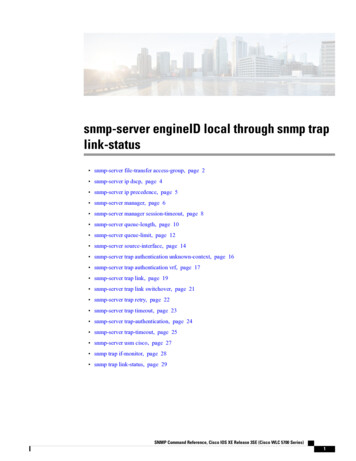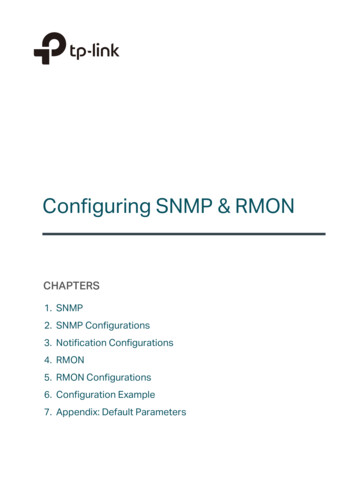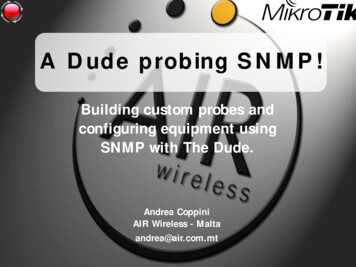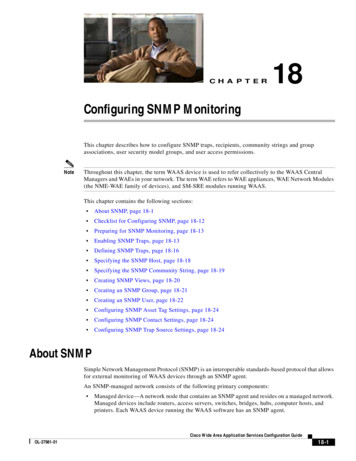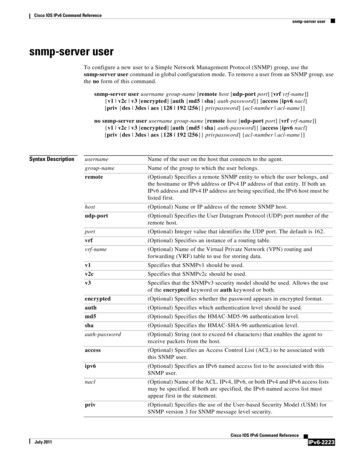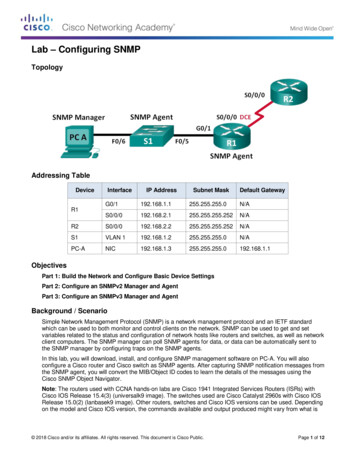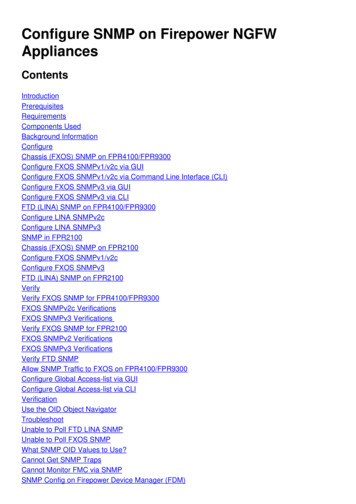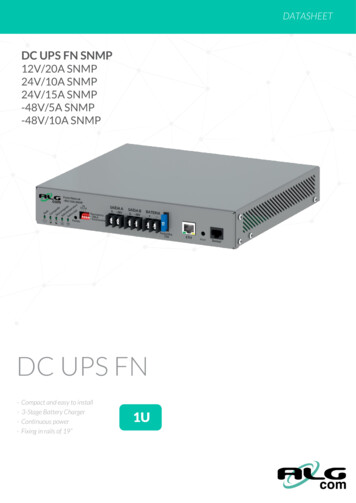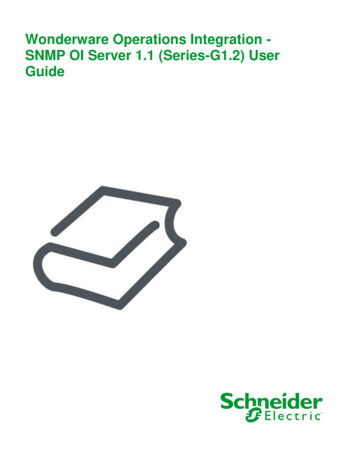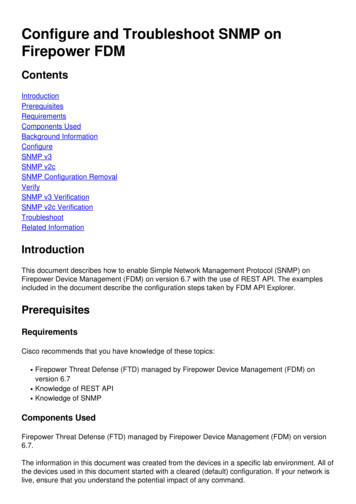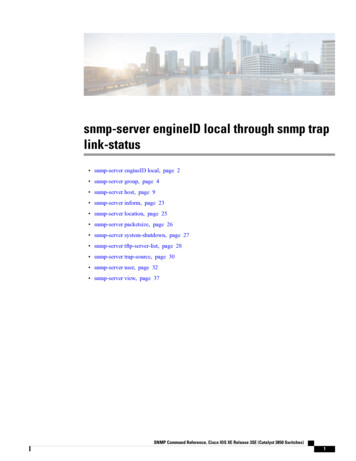
Transcription
snmp-server engineID local through snmp traplink-status snmp-server engineID local, page 2 snmp-server group, page 4 snmp-server host, page 9 snmp-server inform, page 23 snmp-server location, page 25 snmp-server packetsize, page 26 snmp-server system-shutdown, page 27 snmp-server tftp-server-list, page 28 snmp-server trap-source, page 30 snmp-server user, page 32 snmp-server view, page 37SNMP Command Reference, Cisco IOS XE Release 3SE (Catalyst 3850 Switches)1
snmp-server engineID local through snmp trap link-statussnmp-server engineID localsnmp-server engineID localTo specify the Simple Network Management Protocol (SNMP) engine ID on the local device, use thesnmp-server engineID local command in global configuration mode. To remove the configured engine ID,use the no form of this command.snmp-server engineID local engineid-stringno snmp-server engineID local engineid-stringSyntax Descriptionengineid-stringString of a maximum of 24 characters that identifiesthe engine ID.Command DefaultAn SNMP engine ID is generated automatically but is not displayed or stored in the running configuration.You can display the default or configured engine ID by using the show snmp engineID command.Command ModesGlobal configuration (config)Command HistoryUsage GuidelinesReleaseModification12.0(3)TThis command was introduced.12.2(33)SRAThis command was integrated into Cisco IOS Release 12.2(33)SRA.12.2SXThis command is supported in the Cisco IOS Release 12.2SX train.Support in a specific 12.2SX release of this train depends on your featureset, platform, and platform hardware.Cisco IOS XE Release 3.2SEThis command was implemented in Cisco IOS XE Release 3.2SE.Cisco IOS XE Release 3.3SEThis command was implemented in Cisco IOS XE Release 3.3SE.The SNMP engine ID is a unique string used to identify the device for administrative purposes. You do notneed to specify an engine ID for the device; a default string is generated using Cisco’s enterprise number(1.3.6.1.4.1.9) and the MAC address of the first interface on the device. For further details on the SNMPengine ID, see RFC 2571.If you specify your own ID, note that the entire 24-character engine ID is not needed if it contains trailingzeros. Specify only the portion of the engine ID up until the point where only zeros remain in the value. Forexample, to configure an engine ID of 123400000000000000000000, you can specify snmp-server engineIDlocal 1234.SNMP Command Reference, Cisco IOS XE Release 3SE (Catalyst 3850 Switches)2
snmp-server engineID local through snmp trap link-statussnmp-server engineID localThe value for the engine ID is displayed in hexadecimal value pairs. If the length of the input is an odd number,the last digit will be prepended with a zero ("0"). For example, if the engine ID is 12345, the ID is treated as12:34:05 internally. Hence, the engine ID is displayed as 123405 in the show running configuration commandoutput.Changing the value of the SNMP engine ID has significant effects. A user's password (entered on the commandline) is converted to a message digest5 algorithm (MD5) or Secure Hash Algorithm (SHA) security digest.This digest is based on both the password and the local engine ID. The command line password is thendestroyed, as required by RFC 2274. Because of this deletion, if the local value of the engineID changes, thesecurity digests of SNMPv3 users will become invalid, and the users will have to be reconfigured.Similar restrictions require the reconfiguration of community strings when the engine ID changes. A remoteengine ID is required when an SNMPv3 inform is configured. The remote engine ID is used to compute thesecurity digest for authenticating and encrypting packets sent to a user on the remote host.ExamplesThe following example specifies the local SNMP engine ID:Router(config)# snmp-server engineID localRelated CommandsCommandDescriptionshow snmp engineIDDisplays the identification of the local SNMP engineand all remote engines that have been configured onthe router.snmp-server hostSpecifies the recipient (SNMP manager) of an SNMPtrap notification.SNMP Command Reference, Cisco IOS XE Release 3SE (Catalyst 3850 Switches)3
snmp-server engineID local through snmp trap link-statussnmp-server groupsnmp-server groupTo configure a new Simple Network Management Protocol (SNMP) group, use the snmp-server groupcommand in global configuration mode. To remove a specified SNMP group, use the no form of this command.snmp-server group group-name {v1 v2c v3 {auth noauth priv}} [context context-name] [read read-view][write write-view] [notify notify-view] [access [ipv6 named-access-list] [acl-number acl-name]]no snmp-server group group-name {v1 v2c v3 {auth noauth priv}} [context context-name]Syntax Descriptiongroup-nameName of the group.v1Specifies that the group is using the SNMPv1 securitymodel. SNMPv1 is the least secure of the possibleSNMP security models.v2cSpecifies that the group is using the SNMPv2csecurity model.The SNMPv2c security model allows informs to betransmitted and supports 64-character strings.v3Specifies that the group is using the SNMPv3 securitymodel.SMNPv3 is the most secure of the supported securitymodels. It allows you to explicitly configureauthentication characteristics.authSpecifies authentication of a packet withoutencrypting it.noauthSpecifies no authentication of a packet.privSpecifies authentication of a packet with encryption.context(Optional) Specifies the SNMP context to associatewith this SNMP group and its views.context-name(Optional) Context name.read(Optional) Specifies a read view for the SNMP group.This view enables you to view only the contents ofthe agent.SNMP Command Reference, Cisco IOS XE Release 3SE (Catalyst 3850 Switches)4
snmp-server engineID local through snmp trap link-statussnmp-server groupread-view(Optional) String of a maximum of 64 characters thatis the name of the view.The default is that the read-view is assumed to beevery object belonging to the Internet object identifier(OID) space (1.3.6.1), unless the read option is usedto override this state.write(Optional) Specifies a write view for the SNMPgroup. This view enables you to enter data andconfigure the contents of the agent.write-view(Optional) String of a maximum of 64 characters thatis the name of the view.The default is that nothing is defined for the writeview (that is, the null OID). You must configure writeaccess.notify(Optional) Specifies a notify view for the SNMPgroup. This view enables you to specify a notify,inform, or trap.notify-view(Optional) String of a maximum of 64 characters thatis the name of the view.By default, nothing is defined for the notify view (thatis, the null OID) until the snmp-server host commandis configured. If a view is specified in thesnmp-server group command, any notifications inthat view that are generated will be sent to all usersassociated with the group (provided a SNMP serverhost configuration exists for the user).Cisco recommends that you let the softwareautogenerate the notify view. See the “ConfiguringNotify Views” section in this document.access(Optional) Specifies a standard access control list(ACL) to associate with the group.ipv6(Optional) Specifies an IPv6 named access list. Ifboth IPv6 and IPv4 access lists are indicated, the IPv6named access list must appear first in the list.named-access-list(Optional) Name of the IPv6 access list.acl-number(Optional) The acl-numberargument is an integerfrom 1 to 99 that identifies a previously configuredstandard access list.SNMP Command Reference, Cisco IOS XE Release 3SE (Catalyst 3850 Switches)5
snmp-server engineID local through snmp trap link-statussnmp-server groupacl-name(Optional) The acl-name argument is a string of amaximum of 64 characters that is the name of apreviously configured standard access list.Command DefaultNo SNMP server groups are configured.Command ModesGlobal configuration (config)Command HistoryUsage GuidelinesReleaseModification11.(3)TThis command was introduced.12.0(23)SThe context context-name keyword and argument pair was added.12.3(2)TThe context context-name keyword and argument pair was integratedinto Cisco IOS Release 12.3(2)T, and support for standard named accesslists (acl-name) was added.12.0(27)SThe ipv6 named-access-list keyword and argument pair was added.12.2(25)SThis command was integrated into Cisco IOS Release 12.2(25)S.12.3(14)TThe ipv6 named-access-list keyword and argument pair was integratedinto Cisco IOS Release 12.3(14)T.12.2(33)SRAThis command was integrated into Cisco IOS Release 12.2(33)SRA.12.2(31)SB2This command was integrated into Cisco IOS Release 12.2(31)SB2.12.2(33)SXHThis command was integrated into Cisco IOS Release 12.2(33)SXH.Cisco IOS XE Release 2.1This command was introduced on Cisco ASR 1000 Series Routers.12.2(33)SBThis command was integrated into Cisco IOS Release 12.2(33)SB.Cisco IOS XE Release 3.2SEThis command was implemented in Cisco IOS XE Release 3.2SE.Cisco IOS XE Release 3.3SEThis command was implemented in Cisco IOS XE Release 3.3SE.When a community string is configured internally, two groups with the name public are autogenerated, onefor the v1 security model and the other for the v2c security model. Similarly, deleting a community stringwill delete a v1 group with the name public and a v2c group with the name public.SNMP Command Reference, Cisco IOS XE Release 3SE (Catalyst 3850 Switches)6
snmp-server engineID local through snmp trap link-statussnmp-server groupNo default values exist for authentication or privacy algorithms when you configure the snmp-server groupcommand. Also, no default passwords exist. For information about specifying a Message Digest 5 (MD5)password, see the documentation of the snmp-server user command.Configuring Notify ViewsThe notify-view option is available for two reasons: If a group has a notify view that is set using SNMP, you may need to change the notify view. The snmp-server host command may have been configured before the snmp-server group command.In this case, you must either reconfigure the snmp-server host command, or specify the appropriatenotify view.Specifying a notify view when configuring an SNMP group is not recommended, for the following reasons: The snmp-server host command autogenerates a notify view for the user, and then adds it to the groupassociated with that user. Modifying the group’s notify view will affect all users associated with that group.Instead of specifying the notify view for a group as part of the snmp-server group command, use the followingcommands in the order specified:1 snmp-server user --Configures an SNMP user.2 snmp-server group --Configures an SNMP group, without adding a notify view .3 snmp-server host --Autogenerates the notify view by specifying the recipient of a trap operation.SNMP ContextsSNMP contexts provide VPN users with a secure way of accessing MIB data. When a VPN is associated witha context, that VPN’s specific MIB data exists in that context. Associating a VPN with a context enablesservice providers to manage networks with multiple VPNs. Creating and associating a context with a VPNenables a provider to prevent the users of one VPN from accessing information about users of other VPNs onthe same networking device.Use this command with the context context-name keyword and argument to associate a read, write, or notifySNMP view with an SNMP context.ExamplesExamplesThe following example shows how to create the SNMP server group “public,” allowing read-only access forall objects to members of the standard named access list “lmnop”:Router(config)# snmp-server group public v2c access lmnopExamplesThe following example shows how to remove the SNMP server group “public” from the configuration:Router(config)# no snmp-server group public v2cSNMP Command Reference, Cisco IOS XE Release 3SE (Catalyst 3850 Switches)7
snmp-server engineID local through snmp trap link-statussnmp-server groupExamplesThe following example shows SNMP context “A” associated with the views in SNMPv2c group config)#Router(config)#Related Commandssnmp-server context Asnmp mib community commAsnmp mib community-map commA context A target-list commAVpnsnmp-server group GROUP1 v2c context A read viewA write viewA notify viewBCommandDescriptionshow snmp groupDisplays the names of groups on the router and thesecurity model, the status of the different views, andthe storage type of each group.snmp mib community-mapAssociates a SNMP community with an SNMPcontext, engine ID, security name, or VPN target list.snmp-server hostSpecifies the recipient of a SNMP notificationoperation.snmp-server userConfigures a new user to a SNMP group.SNMP Command Reference, Cisco IOS XE Release 3SE (Catalyst 3850 Switches)8
snmp-server engineID local through snmp trap link-statussnmp-server hostsnmp-server hostTo specify the recipient of a Simple Network Management Protocol (SNMP) notification operation, use thesnmp-server host command in global configuration mode. To remove the specified host from the configuration,use the no form of this command.snmp-server host {hostname ip-address} [vrf vrf-name informs traps version {1 2c 3 [auth noauth priv]}] community-string [udp-port port [ notification-type ] notification-type]no snmp-server host {hostname ip-address} [vrf vrf-name informs traps version {1 2c 3 [auth noauth priv]}] community-string [udp-port port [ notification-type ] notification-type]Command Syntax on Cisco ME 3400, ME 3400E, and Catalyst 3750 Metro Switchessnmp-server host ip-address {community-string informs traps} {community-string version {1 2c 3 {auth noauth}}} {community-string vrf vrf-name {informs traps}} [notification-type]no snmp-server host ip-address {community-string informs traps} {community-string version {1 2c 3{auth noauth}}} {community-string vrf vrf-name {informs traps}} [notification-type]Command Syntax on Cisco 7600 Series Routersnmp-server host ip-address {community-string {informs traps} {community-string version {1 2c 3{auth noauth priv}} community-string version {1 2c 3 {auth noauth priv}} community-string vrfvrf-name {informs traps} {community-string version {1 2c 3 {auth noauth priv}} community-string}}}[ notification-type ]no snmp-server host ip-address {community-string {informs traps} {community-string version {1 2c 3{auth noauth priv}} community-string version {1 2c 3 {auth noauth priv}} community-string vrfvrf-name {informs traps} {community-string version {1 2c 3 {auth noauth priv}} community-string}}}[ notification-type ]Syntax DescriptionhostnameName of the host. The SNMP notification host istypically a network management station (NMS) orSNMP manager. This host is the recipient of theSNMP traps or informs.ip-addressIPv4 address or IPv6 address of the SNMPnotification host.vrf(Optional) Specifies that a VPN routing andforwarding (VRF) instance should be used to sendSNMP notifications. In Cisco IOS Release 12.2(54)SE, the vrfkeyword is required.SNMP Command Reference, Cisco IOS XE Release 3SE (Catalyst 3850 Switches)9
snmp-server engineID local through snmp trap link-statussnmp-server hostvrf-name(Optional) VPN VRF instance used to send SNMPnotifications. In Cisco IOS Release 12.2(54)SE, the vrf-nameargument is required.informs(Optional) Specifies that notifications should be sentas informs. In Cisco IOS Release 12.2(54)SE, the informskeyword is required.traps(Optional) Specifies that notifications should be sentas traps. This is the default. In Cisco IOS Release 12.2(54)SE, the trapskeyword is required.version(Optional) Specifies the version of the SNMP that isused to send the traps or informs. The default is 1. In Cisco IOS Release 12.2(54)SE, the versionkeyword is required and the priv keyword isnot supported.If you use the version keyword, one of the followingkeywords must be specified: 1 --SNMPv1. 2c --SNMPv2C. 3 --SNMPv3. The most secure model becauseit allows packet encryption with the privkeyword. The default is noauth.One of the following three optional security levelkeywords can follow the 3 keyword: auth --Enables message digest algorithm5 (MD5) and Secure Hash Algorithm(SHA) packet authentication. noauth --Specifies that the noAuthNoPrivsecurity level applies to this host. This isthe default security level for SNMPv3. priv --Enables Data Encryption Standard(DES) packet encryption (also called“privacy”).SNMP Command Reference, Cisco IOS XE Release 3SE (Catalyst 3850 Switches)10
snmp-server engineID local through snmp trap link-statussnmp-server hostcommunity-stringPassword-like community string sent with thenotification operation.NoteNoteYou can set this string using thesnmp-server host command by itself, butCisco recommends that you define the stringusing the snmp-server communitycommand prior to using the snmp-serverhost command.The “at” sign (@) is used for delimiting thecontext information.(Optional) Specifies that SNMP traps or informs areto be sent to an network management system (NMS)host.udp-port In Cisco IOS Release 12.2(54)SE, the udp-portkeyword is not supported.port(Optional) User Datagram Protocol (UDP) portnumber of the NMS host. The default is 162. In Cisco IOS Release 12.2(54)SE, the portargument is not supported.notification-type(Optional) Type of notification to be sent to the host.If no type is specified, all available notifications aresent. See the “Usage Guidelines” section for moreinformation about the keywords available.Command DefaultThis command behavior is disabled by default. A recipient is not specified to receive notifications.Command ModesGlobal configuration (config)Command HistoryReleaseModification10.0This command was introduced.12.0(3)TThis command was modified. The version 3 [auth noauth priv] syntax was added as part of theSNMPv3 Support feature. The hsrp notification-type keyword was added. The voice notification-type keyword was added.SNMP Command Reference, Cisco IOS XE Release 3SE (Catalyst 3850 Switches)11
snmp-server engineID local through snmp trap link-statussnmp-server hostReleaseModification12.1(3)TThis command was modified. The calltracker notification-type keyword wasadded for the Cisco AS5300 and AS5800 platforms.12.2(2)TThis command was modified. The vrf vrf-name keyword-argument pair was added. The ipmobile notification-type keyword was added. Support for the vsimaster notification-type keyword was added for theCisco 7200 and Cisco 7500 series routers.12.2(4)TThis command was modified. The pim notification-type keyword was added. The ipsec notification-type keyword was added.12.2(8)TThis command was modified. The mpls-traffic-eng notification-type keyword was added. The director notification-type keyword was added.12.2(13)TThis command was modified. The srp notification-type keyword was added. The mpls-ldp notification-type keyword was added.12.3(2)TThis command was modified. The flash notification-type keyword was added. The l2tun-session notification-type keyword was added.12.3(4)TThis command was modified. The cpu notification-type keyword was added. The memory notification-type keyword was added. The ospf notification-type keyword was added.12.3(8)TThis command was modified. The iplocalpool notification-type keyword wasadded for the Cisco 7200 and 7301 series routers.12.3(11)TThis command was modified. The vrrp keyword was added.SNMP Command Reference, Cisco IOS XE Release 3SE (Catalyst 3850 Switches)12
snmp-server engineID local through snmp trap link-statussnmp-server hostReleaseModification12.3(14)TThis command was modified. Support for SNMP over IPv6 transport was integrated into Cisco IOSRelease 12.3(14)T. Either an IP or IPv6 Internet address can be specifiedas the hostname argument. The eigrp notification-type keyword was added.12.4(20)TThis command was modified. The license notification-type keyword was added.15.0(1)MThis command was modified. The nhrp notification-type keyword was added. The automatic insertion of the snmp-server community command intothe configuration, along with the community string specified in thesnmp-server host command, was changed. The snmp-server communitycommand must be manually configured.12.0(17)STThis command was modified. The mpls-traffic-eng notification-type keywordwas added.12.0(21)STThis command was modified. The mpls-ldp notification-type keyword wasadded.12.0(22)SThis command was modified. All features in Cisco IOS Release 12.0ST were integrated into Cisco IOSRelease 12.0(22)S. The mpls-vpn notification-type keyword was added.12.0(23)SThis command was modified. The l2tun-session notification-type keyword wasadded.12.0(26)SThis command was modified. The memory notification-type keyword was added.12.0(27)SThis command was modified. Support for SNMP over IPv6 transport was added. Either an IP or IPv6Internet address can be specified as the hostname argument. The vrf vrf-name keyword and argument combination was added to supportmultiple Lightweight Directory Protocol (LDP) contexts for VPNs.12.0(31)SThis command was modified. The l2tun-pseudowire-status notification-typekeyword was added.12.2(18)SThis command was integrated into Cisco IOS Release 12.2(18)S.SNMP Command Reference, Cisco IOS XE Release 3SE (Catalyst 3850 Switches)13
snmp-server engineID local through snmp trap link-statussnmp-server hostReleaseModification12.2(25)SThis command was modified. The cpu notification-type keyword was added. The memory notification-type keyword was added.12.2(28)SBThis command was integrated into Cisco IOS Release 12.2(28)SB.12.2(33)SRAThis command was integrated into Cisco IOS Release 12.2(33)SRA.12.2(31)SB2The cef notification-type keyword was added.12.2(33)SXHThis command was integrated into Cisco IOS Release 12.2(33)SXH.12.2(33)SBThis command was integrated into Cisco IOS Release 12.2(33)SB.12.2(33)SXI5This command was modified. The dhcp-snooping notification-type keyword was added. The errdisable notification-type keyword was added.12.2(54)SEThis command was modified. See the snmp-server host, on page 9 for thecommand syntax for these switches.12.2(33)SXJThis command was integrated into Cisco IOS Release 12.2(33)SXJ. The publicstorm-control notification-type keyword was added.15.0(1)SThis command was modified. The flowmon notification-type keyword wasadded.Cisco IOS XE Release 2.1 This command was integrated into Cisco IOS XE Release 2.1.Usage Guidelines15.2(1)SThis command was modified. The p2mp-traffic-eng notification-type keywordwas added.Cisco IOS XE Release3.2SEThis command was implemented in Cisco IOS XE Release 3.2SE.Cisco IOS XE Release3.3SEThis command was implemented in Cisco IOS XE Release 3.3SE.If you enter this command with no optional keywords, the default is to send all notification-type traps to thehost. No informs will be sent to the host.The no snmp-server host command with no keywords disables traps, but not informs, to the host. To disableinforms, use the no snmp-server host informs command.SNMP Command Reference, Cisco IOS XE Release 3SE (Catalyst 3850 Switches)14
snmp-server engineID local through snmp trap link-statussnmp-server hostNoteIf a community string is not defined using the snmp-server community command prior to using thiscommand, the default form of the snmp-server community command will automatically be inserted intothe configuration. The password (community string) used for this automatic configuration of thesnmp-server community command will be the same as that specified in the snmp-server host command.This automatic command insertion and use of passwords is the default behavior for Cisco IOS Release12.0(3) and later releases. However, in Cisco IOS Release 12.2(33)SRE and later releases, you mustmanually configure the snmp-server community command. That is, the snmp-server communitycommand will not be seen in the configuration.SNMP notifications can be sent as traps or inform requests. Traps are unreliable because the receiver doesnot send acknowledgments when it receives traps. The sender cannot determine if the traps were received.However, an SNMP entity that receives an inform request acknowledges the message with an SNMP responseprotocol data unit (PDU). If the sender never receives the response, the inform request can be sent again.Thus, informs are more likely to reach their intended destination than traps.Compared to traps, informs consume more resources in the agent and in the network. Unlike a trap, which isdiscarded as soon as it is sent, an inform request must be held in memory until a response is received or therequest times out. Also, traps are sent only once; an inform may be tried several times. The retries increasetraffic and contribute to a higher overhead on the network.If you do not enter an snmp-server host command, no notifications are sent. To configure the router to sendSNMP notifications, you must enter at least one snmp-server host command. If you enter the command withno optional keywords, all trap types are enabled for the host.To enable multiple hosts, you must issue a separate snmp-server host command for each host. You canspecify multiple notification types in the command for each host.When multiple snmp-server host commands are given for the same host and kind of notification (trap orinform), each succeeding command overwrites the previous command. Only the last snmp-server hostcommand will be in effect. For example, if you enter an snmp-server host inform command for a host andthen enter another snmp-server host inform command for the same host, the second command will replacethe first.The snmp-server host command is used in conjunction with the snmp-server enable command. Use thesnmp-server enable command to specify which SNMP notifications are sent globally. For a host to receivemost notifications, at least one snmp-server enable command and the snmp-server host command for thathost must be enabled.Some notification types cannot be controlled with the snmp-server enable command. Some notification typesare always enabled, and others are enabled by a different command. For example, the linkUpDown notificationsare controlled by the snmp trap link-status command. These notification types do not require an snmp-serverenable command.The availability of notification-type options depends on the router type and the Cisco IOS software featuressupported on the router. For example, the envmon notification type is available only if the environmentalmonitor is part of the system. To see what notification types are available on your system, use the commandhelp ? at the end of the snmp-server host command.The vrf keyword allows you to specify the notifications being sent to a specified IP address over a specificVRF VPN. The VRF defines a VPN membership of a user so that data is stored using the VPN.In the case of the NMS sending the query having a correct SNMP community but not having a read or a writeview, the SNMP agent returns the following error values:SNMP Command Reference, Cisco IOS XE Release 3SE (Catalyst 3850 Switches)15
snmp-server engineID local through snmp trap link-statussnmp-server host For a get or a getnext query, returns GEN ERROR for SNMPv1 and AUTHORIZATION ERROR forSNMPv2C. For a set query, returns NO ACCESS ERROR.Notification-Type KeywordsThe notification type can be one or more of the following keywords.NoteThe available notification types differ based on the platform and Cisco IOS release. For a complete listof available notification types, use the question mark (?) online help function. aaa server --Sends SNMP authentication, authorization, and accounting (AAA) traps. adslline --Sends Asymmetric Digital Subscriber Line (ADSL) LINE-MIB traps. atm --Sends ATM notifications. authenticate-fail --Sends an SNMP 802.11 Authentication Fail trap. auth-framework --Sends SNMP CISCO-AUTH-FRAMEWORK-MIB notifications. bgp --Sends Border Gateway Protocol (BGP) state change notifications. bridge --Sends SNMP STP Bridge MIB notifications. bstun --Sends Block Serial Tunneling (BSTUN) event notifications. bulkstat --Sends Data-Collection-MIB notifications. c6kxbar --Sends SNMP crossbar notifications. callhome --Sends Call Home MIB notifications. calltracker -- Sends Call Tracker call-start/call-end notifications. casa --Sends Cisco Appliances Services Architecture (CASA) event notifications. ccme --Sends SNMP Cisco netManager Event (CCME) traps. cef --Sends notifications related to Cisco Express Forwarding. chassis --Sends SNMP chassis notifications. cnpd --Sends Cisco Network-based Application Recognition (NBAR) Protocol Discovery (CNPD)traps. config --Sends configuration change notifications. config-copy --Sends SNMP config-copy notifications. config-ctid --Sends SNMP config-ctid notifications. cpu --Sends CPU-related notifications. csg --Sends SNMP Content Services Gateway (CSG) notifications. deauthenticate --Sends an SNMP 802.11 Deauthentication trap. dhcp-snooping --Sends DHCP snooping MIB notifications.SNMP Command Reference, Cisco IOS XE Release 3SE (Catalyst 3850 Switches)16
snmp-server engineID local through snmp trap link-statussnmp-server host director --Sends notifications related to DistributedDirector. disassociate --Sends an SNMP 802.11 Disassociation trap. dlsw --Sends data-link switching (DLSW) notifications. dnis --Sends SNMP Dialed Number Identification Service (DNIS) traps. dot1x --Sends 802.1X notifications. dot11-mibs --Sends dot11 traps. dot11-qos --Sends SNMP 802.11 QoS Change trap. ds1 --Sends SNMP digital signaling 1 (DS1) notifications. ds1-loopback --Sends ds1-loopback traps. dspu --Sends downstream physical unit (DSPU) notifications. eigrp --Sends Enhanced Interior Gateway Routing Protocol (EIGRP) stuck-in-active (SIA) and neighborauthentication failure notifications. energywise --Sends SNMP energywise notifications. entity --Sends Entity MIB
snmp-server engineID local through snmp trap link-status snmp-serverengineIDlocal,page2 snmp-servergroup,page4 snmp-serverhost,page9 snmp-serverinform,page23 snmp-serverlocation,page25 snmp-serverpacketsize,page26 snmp-serversystem-shutdown,page27
